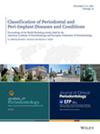Clear aligners and open gingival embrasures: Retrospective study of epidemiology and risk factors
IF 4.2
2区 医学
Q1 DENTISTRY, ORAL SURGERY & MEDICINE
引用次数: 0
Abstract
BackgroundTo investigate the epidemiology and risk factors of open gingival embrasures (OGE) in adult patients after clear aligner therapy (CAT).MethodsA total of 518 adult patients were recruited to evaluate the prevalence and severity of OGE between central incisors through intraoral photographs; 281 patients with complete lateral cephalometric radiographs and cone‐beam computed tomography (CBCT) were selected above to investigate mainly mesiodistal anatomical indicators regarding the occurrence and severity of OGE; and 186 non‐extraction (NE) patients were selected from 281 patients to further investigate the relationship between tooth movement or labial‐palatal/lingual anatomical indicators with OGE.ResultsThe prevalence of OGE was relatively high and significantly associated with tooth extraction. The prevalence and severity of OGE decreased as follows: one‐lower‐incisor‐extraction > two‐premolar‐extraction > NE types. The interproximal contact point‐alveolar crest (ICP‐AC) > 5 mm, ΔICP‐AC > 0.5 mm, cemento‐enamel junction‐alveolar crest (CEJ‐AC) > 2 mm, and ΔCEJ‐AC > 0.2 mm were significantly associated with the occurrence of OGE. ΔCEJ‐AC may more sensitively reflect bone loss, meanwhile, CEJ‐AC in distal sites was significantly associated with moderate or severe OGE in mesial sites. Intrusion movement < 2 mm and labial inclination < 5° were the warning limits for incisor movement. Furthermore, we found that bone dehiscence and root resorption were significantly associated with OGE.ConclusionOGE of varying severity could be accompanied by different degrees of three‐dimensional alveolar bone resorption. Moderate‐to‐severe OGE may occur alongside other complications in orthodontic treatment. This research also provided valuable clinical insights and treatment guidance in CAT.Plain Language SummaryClear aligner therapy (CAT) is a favored orthodontic choice for adults, yet it can carry hidden risks to periodontal health. Open gingival embrasure (OGE), or “black triangles” between teeth, can affect aesthetics, promote food impaction, and potentially relate to underlying bone loss. Our large‐sample study investigated the incidence of OGE, identified the treatment alternatives associated with increased risk, how OGE related to alterations in tissue loss and tooth movement, and what risks OGE may indicate. The prevalence of OGE is relatively high in adult patients after CAT. Patients with a single lower incisor removed had the highest rates and severity of OGE, followed by those with two premolars extracted, and finally those with no extractions. Detailed imaging revealed that the occurrence and severity of OGE are significantly associated with bone loss, not only between teeth but also from the front‐back directions. Additionally, specific thresholds for tooth movement that may elevate OGE risk include excessive incisor intrusion or forward tilting. Importantly, OGE often occurred along with other complications like bone dehiscence or root resorption. Our findings provide anatomical data on the potential three‐dimensional tissue loss associated with different severities of OGE and further provide clinical guidance in CAT.透明对准器和开放式牙龈膜:流行病学和危险因素的回顾性研究
背景探讨成人患者行清除矫正器治疗(CAT)后开放性龈囊(OGE)的流行病学及危险因素。方法对518例成年患者进行口腔内摄影,评估中切牙间OGE的患病率及严重程度;本文选取281例完整侧位头颅x线片和锥形束计算机断层扫描(CBCT)患者,主要研究与OGE发生和严重程度有关的中远端解剖学指标;从281例患者中选择186例非拔牙(NE)患者,进一步研究牙齿运动或唇-腭/舌解剖指标与OGE的关系。结果OGE患病率较高,且与拔牙有显著相关性。OGE的患病率和严重程度下降如下:1 -下门牙-拔牙;两前磨牙量提取比;NE类型。近端接触点-牙槽嵴(ICP‐AC) >;5mm, ΔICP‐AC >;0.5 mm,牙骨质-牙釉质交界处-牙槽嵴(CEJ - AC) >;2毫米,ΔCEJ‐AC >;0.2 mm与OGE的发生显著相关。ΔCEJ‐AC可能更敏感地反映骨质流失,同时,远端CEJ‐AC与中端中度或重度OGE显著相关。入侵运动<;2毫米及唇倾<;5°为切牙运动的警戒线。此外,我们发现骨裂和根吸收与OGE显著相关。结论不同程度的oge可伴有不同程度的三维牙槽骨吸收。在正畸治疗中,中度至重度OGE可能与其他并发症一起发生。本研究也为CAT提供了有价值的临床见解和治疗指导。清晰矫正器治疗(CAT)是成人首选的正畸治疗方法,但它可能对牙周健康存在潜在风险。开放的牙龈囊膜(OGE),或牙齿之间的“黑色三角形”,会影响美观,促进食物嵌塞,并可能与潜在的骨质流失有关。我们的大样本研究调查了OGE的发生率,确定了与风险增加相关的治疗方案,OGE与组织丢失和牙齿移动的改变之间的关系,以及OGE可能表明的风险。成人CAT术后OGE患病率较高。单下切牙拔除组的OGE发生率和严重程度最高,其次是双前磨牙拔除组,最后是未拔除组。详细的影像学显示OGE的发生和严重程度与骨丢失显著相关,不仅在牙齿之间,而且在前后方向。此外,可能增加OGE风险的牙齿运动的特定阈值包括门牙过度侵入或前倾。重要的是,OGE经常与其他并发症如骨裂或根吸收一起发生。我们的研究结果提供了与不同严重程度的OGE相关的潜在三维组织损失的解剖学数据,并进一步为CAT提供临床指导。
本文章由计算机程序翻译,如有差异,请以英文原文为准。
求助全文
约1分钟内获得全文
求助全文
来源期刊

Journal of periodontology
医学-牙科与口腔外科
CiteScore
9.10
自引率
7.00%
发文量
290
审稿时长
3-8 weeks
期刊介绍:
The Journal of Periodontology publishes articles relevant to the science and practice of periodontics and related areas.
 求助内容:
求助内容: 应助结果提醒方式:
应助结果提醒方式:


